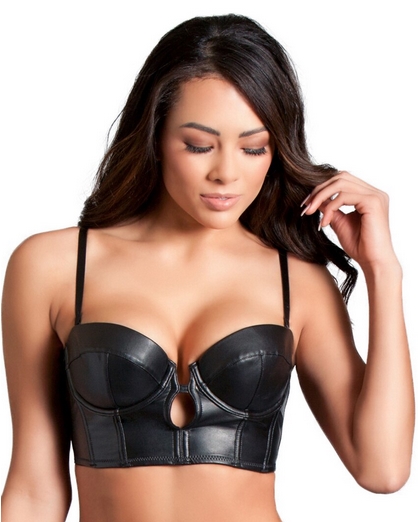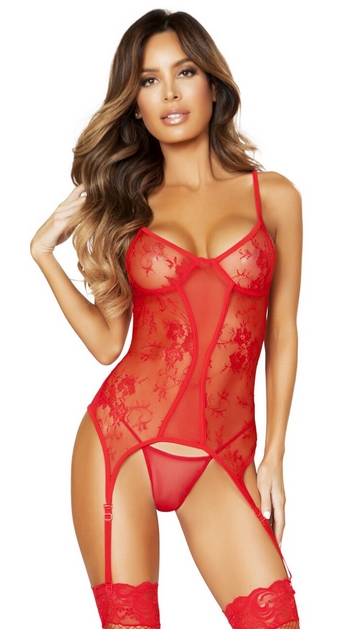Disclosure: This post may contain affiliate links. I receive a small commission at no cost to you when you make a purchase using my link.
Whether you’re in a bridal mood or just want a great Throwback Thursday snap inspired by the 80s or the 50s – you’re a great candidate for a bustier.
Bustiers are a unique form of lingerie. Not only do they have a very ancient history, but they’re also very closely related to the corset.
The Blonde Ambition Tour, anyone? Indeed, Jean-Paul Gaulthier’s iconic, custom bullet bustier that was exclusively made for the Material Girl herself has reverberated through runways, sewing rooms, and design boards in the decades since.
It’s not just Madonna, either. High profile actresses and songstresses like Katy Perry, Nicki Minaj, Taylor Swift, and Ariana Grande have stepped into a bustier at one point. And how could we forget the immortalized singer Selena Quintanilla? The bustier was a wardrobe staple for her.
So, let’s dive in. We’ll cover what bustier lingerie is, a brief history, and go over how they differ from the corset. Oh, and of course we’d be remiss if we didn’t include some style and care tips!

What is Bustier Lingerie?
The term bustier originates from the French term buste. This, of course, means bust. The bustier is essentially a very long bra that usually stops at the waist and occasionally the hips.
A bustier will have built-in cups and a very tight waist to encourage a fuller bust and cleavage. It’s normally sleeveless, which gives it some serious versatility as an undergarment. The bustier may or may not include plastic boning or mesh panels for additional shaping and is generally very flexible.
Common fabrics for bustier lingerie are satin, silk, and nylon. Bustier lingerie is usually fastened with hook-and-eye fasteners.
As a piece of outerwear, a bustier top will generally have straps ranging from thick to spaghetti sized and fabrics range from velvet to cotton to rayon.
A Brief History Of The Bustier:
When the bustier originated is opaque. Some sources indicate it could have been as far back as 2000 BCE, the 16th century, or the 19th century. Now, something to bear in mind during this brief history lesson is that bustiers are commonly misconstrued as corsets in history.
As we know, there have been reports of the bustier emerging in the 16th century. They may have been made of linen and thought to compliment the multi-layered skirts worn during that time. Intricate designs may have been highly favored amongst the nobility and were likely spearheaded by iconic women of history such as Catherine de Medici and Elizabeth I, which would have quickly spread through the fashionable courts of Europe when each woman favored this silhouette.
As far as the 18th and 19th centuries go, we know that a ‘cinched’ look with an impossibly small waist was very desirable in Victorian and Edwardian times, and bustiers were often homemade amongst middle to lower class women. As time pressed on, mass production became more commonplace and the bustier started to function more as the brassiere we know and love today rather than as stylish addition to outerwear.
In the 1950s and 1960s, the eyes of fashion took note of the bustier in earnest. Iconic starlets like Marilyn Monroe immortalized the very small waist and flared skirt silhouette, and with the introduction of nylon as a fabric, mass production became all too easy.
The 80s and 90s brought fashion reform, political reform, and musical reform. The bustier was all over the place. Movies, television, books, music videos. We of course referenced Madonna’s Blonde Ambition tour, but there are notable episodes of Sex and the City as well as Friends that featured the bustier as a wardrobe choice.
These days, the bustier is a delicate piece of bridal (or every day) lingerie. Bustiers in outerwear are sleek and velvety; a marriage of the chic 2020s to the wild rock and roll fashion of the 1980s.

Style Tips
In the bedroom, we love a garter bustier combined with matching panties. Pair this ensemble with a silky robe and slippers and you’ll feel like you’re born to mysteriously swan around a mansion.
Bustiers are perfect for weddings and honeymoons. Not only are they a wonderful shapewear and support choice for the big day, but you get that extra oomf with its bust shaping capabilities.
As far as outerwear goes, the sky’s the limit, honey. Bustiers are huge right now and show serious staying power. Here are our favorite looks:
- Layer a matching bustier and skirt over a crisp white t-shirt – instant chic.
- Planning an evening out? Dig out those mom jeans or wide-legged dress pants and pair either with a velvety bustier for an effortless look.
- Best of both worlds? You’ve got it. Pair a demure, lacy bustier with a tea-length skirt for an instant vintage look that will keep you cool for the summer. Right, Demi?
Care Instructions
It almost goes without saying now, but we know that lingerie pieces aren’t suitable for the washing machine. Unless the washing instructions say otherwise, always hand wash your lingerie in warm or cool water and lay flat to dry.
Bustiers tend to have a slight bit of shape, so avoid wringing it out as this can cause warping to the delicate paneling. Instead, press it gently between two large towels to absorb that extra water before laying it flat to dry.
If your bustier is a piece of outerwear, there won’t be a ton of shaping qualities there. Depending on the fabric, you should be able to machine wash on a gentle cycle and lay flat to dry.
Always follow your care instructions on the garment for best results.
Bustier vs. Corset
The corset essentially birthed the concept of the bustier as well as its sister-piece the basque, but the corset and bustier pieces are different.
A bustier serves to provide shape and support just as a corset does, but a bustier places a distinct focus on enhancing and supporting the bust, while a corset focuses more on cinching the waist.
Corsets will also always incorporate heavier boning within the fabric, can be quite stiff, and usually are always sold in a limited range of sizes as they rely on adjustable lacing for individual sizing. This is great for cosplay, costuming, and waist training – but does not offer much flexibility. Bustiers do not have lacing as a general rule and are available in traditional sizes as well as petite and plus.




Leave a Reply